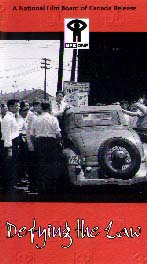|
________________
CM . . . .
Volume VI Number 12 . . . . February 18, 2000
excerpt: "It isn't the pay increases or even the dues checkoffs that I most remember, but the benefits which could not be measured in dollars and cents. It's the memory of that first day on the picket line. I feel it yet. That feeling of freedom that we all felt by breaking the hold that Stelco had on us. And above all that we grew to conquer our own fears." (Reg Gardiner, striker)This video relates the events of the strike at the Stelco steel plant in Hamilton in 1946. The strike, which lasted seven weeks, spawned violence and unrest, pitted neighbour against neighbour, and is considered by many to be the birth of the modern Canadian labour movement. The story is told using newsreels and newspaper articles from the time and the personal memories of many of the people involved. After the Second World War, men returning to work in Canada wanted to enjoy the benefits of their sacrifices and struggles by obtaining fairer wages and better working conditions. The government of Canada seemed to side with industry in denying the workers their requests and by holding down wage increases. The steel industry was put under government control, and all employees were threatened with imprisonment if they went on strike. In July 1946, a group of steel workers, the minority of whom belonged to a union, voted to strike. Stelco employed strikebreakers to keep making steel, keeping them inside the plant and bringing in food and supplies. These strikebreakers were paid triple time, which particularly angered the strikers. Emotions flared. Strike sympathizers vandalized the homes of the "scabs" and terrorized their families. There was violence on the picket lines as the company attempted to move supplies in and steel out. Public sympathy seemed to be with the strikers, but the government was slow to step in to settle the strike. Five hundred police were brought in to enforce law and order, but support staff at the barracks (cooks, cleaners etc.) refused to serve the policemen if they moved against the strikers, and so the law officers were never used. The strike ended after 86 days with the union gaining an hourly raise only 3.5 cents more than the company had offered in the first place. However, they also achieved a two-week vacation after a year's employment, a great advance. After the strike, all the workers joined the union. The video follows the story of the strike in great detail and succeeds in making a potentially dull subject very interesting. The filmmaker, Richard Nielsen, was one of the strikers, and he provides an account of the dramatic events which captured the attention of the entire nation and which continue to resonate to this day. Recommended. Luella Sumner is a librarian at the Red Rock Public Library in Red Rock, ON.
To comment on this title or this review, send mail to cm@umanitoba.ca.
Copyright © the Manitoba Library Association.
Reproduction for personal use is permitted only if this copyright notice
is maintained. Any other reproduction is prohibited without
permission.
Published by
TABLE OF CONTENTS FOR THIS ISSUE - February 18, 2000.
AUTHORS |
TITLES |
MEDIA REVIEWS |
PROFILES |
BACK ISSUES |
SEARCH |
CMARCHIVE |
HOME
|
